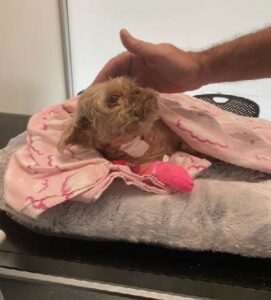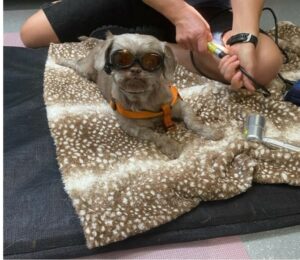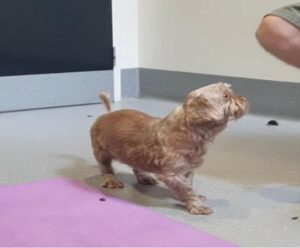Physiotherapy following canine intervertebral disc disease of the spine.
12 March 2023
Australian Physiotherapy Association, a trusted partner of Petcover has provided the below case Study of Cocoa.
Read on to hear about her story, from diagnoses, surgery, physiotherapy treatment, and her recovery.
Physiotherapy following canine intervertebral disc disease of the spine.
Presenting condition and veterinary diagnosis
Meet Cocoa. She is an adorable 11 year and 7-month-old chocolate Shih Tzu who came to see the specialist team at Queensland Veterinary Specialists in November 2021 after she developed progressive loss of walking and ability to use all four limbs. Cocoa underwent a spinal CT myelogram and was diagnosed with intervertebral disc disease, affecting the cervical spine at C6 – C7 and compressing the spinal cord. Cocoa was taken to surgery where a ventral slot procedure was performed to remove the extruded disc material and allow the spinal cord to return to its normal position within the spinal canal.

Physiotherapy Assessment
Physiotherapy assessment began as soon as Cocoa was medically well enough to participate. On initial assessment, Cocoa was found to have reduced movement in her neck, and her hips (due to longstanding osteoarthritis). Cocoa had altered muscle tone, causing low tone (weakness) in the neck and forelimbs and high tone (spasticity) in her hindlimbs. This meant Cocoa was unable to move her body, change positions, sit up, or stand. The change in muscle tone was also a source of discomfort for Cocoa.
Treatment provided
Physiotherapy initially involved a passive range of motion to maintain movement in the forelimb and hindlimb joints. Physiotherapy exercises focused on functional movement patterns such as lifting the head, half-sitting, and rolling from one side to side, retraining Cocoa to be able to change body positions independently.
Cocoa was supported in standing and positioned optimally so she could develop strength in her neck muscles and engage with the world – these are all necessary foundational steps from which to start walking. Cocoa was fortunate to have a great nursing team at Queensland Veterinary Specialists who were able to complete her exercises four times daily under the direction of the physiotherapist.
Cocoa received low-level laser therapy for stimulating wound healing (see photo below). The light emitted from the laser increases blood flow, assists vital cellular functions, and encourages the growth of healthy new tissue.
Cocoa needed some encouragement with her walking, so we chose to utilize the underwater treadmill for facilitating this, as well as unloading any painful joints affected by her known osteoarthritis. In addition, walking in water provides resistance and this facilitates increases in muscle strength, allowing for strength and conditioning of the muscle groups specific to walking. We raised the water level to an appropriate height which allowed Cocoa to stand independently (supported by the buoyancy of the water), and by the end of the first session, Cocoa was taking her first steps.


Outcome
At the time of writing this case study report it has been three months since Cocoa had surgery. Cocoa is able to do most things independently, is now walking 100 metres, and is back to her happy, cheeky self! Cocoa continues to attend physiotherapy where we are focusing on strength and endurance exercises for both the fore and hindlimb muscles to further refine and improve her movements and walking quality.


*This case study is provided by and published on behalf of the Australian Physiotherapy Association. The content contained or made available through this case study is not intended to provide and does not constitute medical advice nor it can be relied upon as care, cure, or treatment for any medical condition. Always seek the advice of your qualified veterinary provider with any questions you may have regarding a medical condition or treatment.
**Claims, coverage, and premiums will vary depending on each individual claim and cover eligibility criteria and terms and conditions will apply. For further information please refer to your individual certificate of insurance and product disclosure statement. PDS is available on the product page of our website.